Public access and the ethics of fishing trespass
Public access is the greatest gift fishing enthusiasts enjoy from the State, and it comes with many conditions attached. It grants equal ability to enjoy the world’s most prized environments to anyone with a fishing license and means to arrive. But it’s always under fire, and comes with increasingly murky definitions of exactly what’s at stake, and where you can or can’t go.
The fishing world, in its advocacy and activism for the environment, is continuously stretching out to thwart the interests of those with money and power as they seek to keep everyday folks from using public waterways. The idea that real, unfettered wilderness land use expands our citizenry’s notion of its stewardship better than visits to safari parks is very compelling. But powerful interests continue to try and keep lands for themselves.
Last year, Montana’s HB 309 tried to re-classify many rivers as ditches to keep people off them. It was ultimately defeated in March after major public outcry. In Virginia, developers are drawing back to regulations from the state’s time as a British colony to sue anglers for trespass, even after after the state would not prosecute them. Michigan’s government is currently attempting to stop the its Department of Natural Resources from acquiring more land, which would ultimately limit fishermen. There are any number of other cases in waterways near you, and you’d be wise to join those following their progress.
But for all the earnest, above-the-board activity keeping bureaucrats and developers in their offices honest, reminding them there’s a whole lot of citizens out there who love to fish, it may be time to rethink what exactly is at stake, morally and ethically speaking, with river trespass.
Lots of opinions in this area stretch back to our antiquated notion of poaching. Of course, taking game illegally is a major issue, and should be condemned and frowned upon.
There’s still mystique around the gentleman poacher, the throwback hallowed in books like Danny, Champion of the World, where a put-upon village conspires to relieve a wicked landowner of his pheasants. This warm idea of a kindly fella with a flat cap persists, despite the overpowering reality that most American sporting poaching consists of deer hastily-gutted and de-loined in the dead of night. Poaching is an ancient-feeling thing, and certainly not what catch-and-release fishermen ever practice, by definition. So, abandon the idea of poaching, of sneaking around and furtive theft. If you’re not keeping fish, you’re not stealing.
And trespass, especially one leaving no trace, is not environmental crime. A fisherman practicing catch-and-release with barbless hooks is nowhere near as damaging as a trawler hauling a miles-long tuna line. It’s a crime against private ownership, not against a fishery or a community. It’s unlikely minor disturbances of river bottom has any lasting consequence to fish, to their homes, or to anglers who’re coming afterwards. In fact, given the amount of movement we know fish do along rivers during their life cycle, taking fish from anywhere on the river is likely to be just as detrimental to landowners along that stretch.
It’s better to think of open access as going out-of-bounds in the backcountry skiing sense than poaching or environmental crime. You’re not really harming anything, but it’s a liability issue, an issue of legal documentation, and one of personal conduct.
If you want access, you learn every letter of your state’s law, you stretch it to every applicable angle, as a lawyer would. But don’t be a jerk. Even if you have the right to be in the water, wading through an area surrounded by private property, don’t walk through water others are fishing, or float through and fish directly in front of someone’s picnic. Try to be invisible to other people using the water.
If that won’t get you where you want to be, find the landowner and ask. Maybe they’ll say OK. Maybe you can let them know about the group of volunteers stewarding that river’s good health, and let them know instituting a flies-only, catch-and-release section would buy them good favor and status as a patron of the sport. Maybe they’ve been thinking about developing a conservation easement but don’t know how.
If you’re truly shut out and run out of other river to enjoy, at least develop a system and priorities. One group of Iowa rafters has written its ‘Ninja Camping’ guide to work with potentially dangerous laws about where and when you can stop for the night on the river. Their conclusions? Avoiding nuisance, damage, destruction and the like can help keep the spirit of the law when the letter gets a bit obscured by necessity.
Dapper Don
 Dapper Don himself
Dapper Don himself
Fly Fisherman has a great story about a true trout stalker named Don, who, with his 14-foot noodle, daps for trout all through the glory zone in western Montana and Idaho.
Even if you doubt you’ll ever try that technique, check it out if you’d like to consider a bit more about how to move to a more sight-fishing, patience oriented trout approach.
I’m in awe of how he’s rebuilt his approach around patience, from gear to the cycle of his day (he often comes to a spot twice a day, to pre-scout in high light and fish in low light). This is such a great value to apply to any outdoor pursuit, especially the appreciation of large brown trout.
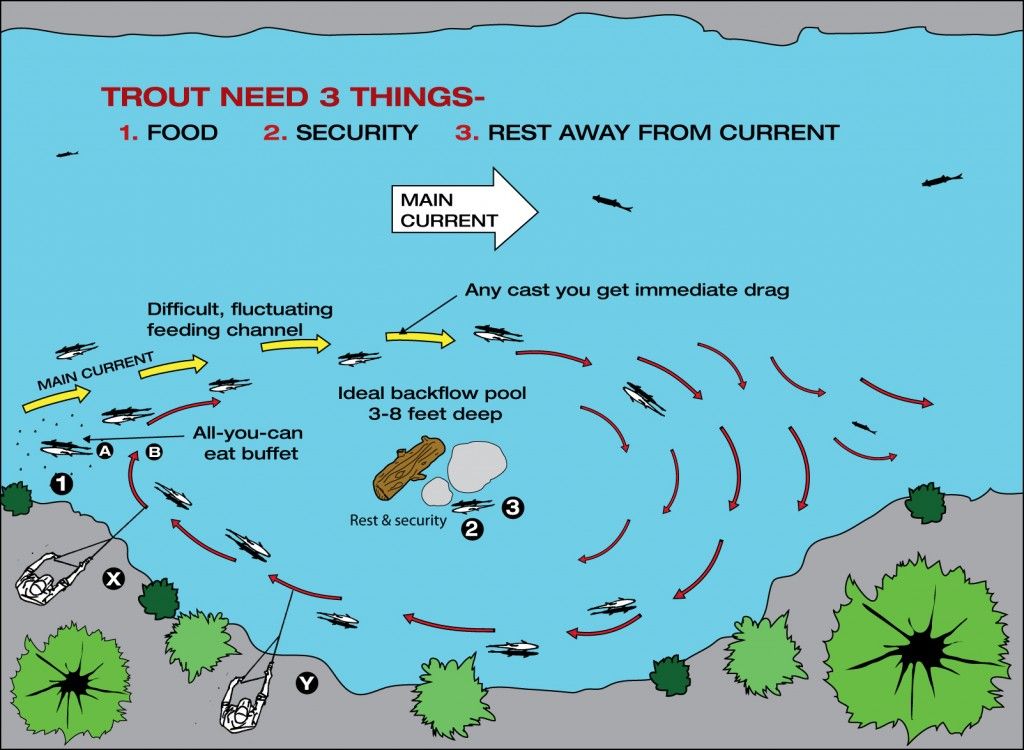 Eddy cycle, illustrated
Eddy cycle, illustrated
This illustration is a great example of how to break down an eddy situation. The trick is figuring out where the large fish are jockeying for position.
Somerset in January: Reminders of Fish

I spent yesterday horsing around at the Fly Fishing Show in Somerset, New Jersey. It’s always a nice thrill to get to break out of the winter doldrums for a day and get to feel some good fishing vibes.
A trio of us headed down from NYC, about a 40 minute drive, to hang around with the Veteran Anglers of New York folks and spot some bargains, refill the gear bins and limber up our wallets. I made it out of there relatively unscathed, with a ton of hooks and the feathers and fur you see above (grouse, starling, hen grizzly, muskrat) and not a whole lot else. I picked up Jay Fullum’s new book, and had a few words with him. I met Rob Snowhite, and can’t wait to check out his podcast. I listened to Lefty Kreh run through some hilarious anecdotes while he waited to start his casting demo. And talked to a fellow who can introduce me to the right outfitters, should I wind up in Argentina later this year. And I saw good old Al Haxton and Charlie Gregory from the Michigan Fly Fishing Club, which once again represented en masse at the show.
Mostly it’s a good reminder of how close-knit the fly fishing industry is. Everyone seems to know everyone else, and once you get beyond the mere punters you realize that it’s a business built on relationships, like any other.
Notably absent was Orvis, which was a little strange. Orvis’ frontman for community stuff, the venerable Tom Rosenbauer, was there, but the brand had no real presence. Rob and I chatted about this briefly, but I’m not sure entirely why this was. Perhaps because there were 5-6 fly shops there that stock Orvis products, and it doesn’t want to mess with its dealers? But certainly a corporate booth, with some new prototype rods, and some super sport-specific stuff would make sense. Same with Patagonia. One of the shops had a load of coats and clothing, but I saw no Patagonia waders. Being a leader means being at things like Somerset, which is why core users might gravitate to Simms or TFO and leave Orvis and Patagonia to dilettantes.
Winter Dip
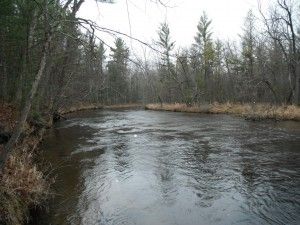
The people in town for skiing sure weren’t liking it, but it was mild enough last week in Michigan to get onto the Pere Marquette with little fuss. The old man tried to stick me with the shitty waders, but he didn’t realize the Cabela’s neoprene model was a much better choice in 38 degree water. We lasted about four hours before we started feeling drunk and sloppy and slow with the cold. That’s generally enough of a reminder of good old Uncle Hypo to get us out of the water, before you slip and take a dip or snap a rod on the trail.
We were looking for the elusive Great Lakes steelhead, with stout eight weights and strong leaders, but no fish were seen or heard from. Egg flies, nymphs, and a few streamers in the afternoon weren’t moving anything. But it was worth it to get out on a great river for a few hours when it would normally be much, much colder.
King time!
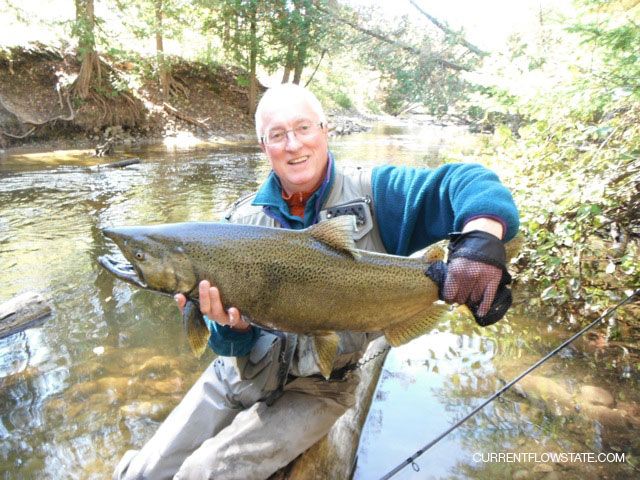
The old man pulled out a bunch of nice chinooks this week, swinging egg flies in the back yard.
Lawfully Wadered: a Fly-Fishing Wedding
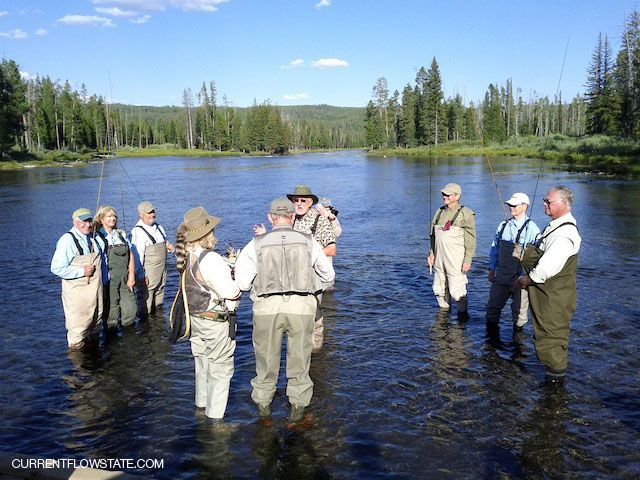
I’m at the age where you go to a lot of weddings (Lady CFS and I are planning one ourselves) but I didn’t think the annual Montana trip would include one. But was I ever wrong! Two members of the club got wedded, while wader-ed, on the Henry’s Fork of the Snake river down in Idaho. It was pretty unique.
In that spirit, here’s a “Top 10 things to remember when planning or attending a fly-fishing wedding” list. Because, one day, you too might wind up at one.
Wear your formal waders
Rods line up in descending order for the arch: bamboo, Winston, all others
Nippers can be used to clip errant nose hairs that have grown long after a few weeks on the river. Do not use forceps.
Choose a river no one has fished well (in our case, the Henry’s Fork of the Snake) and you might just infuse a bit of luck.
Pepper the ceremony with quotable bits. In our case Darius Larsen of All Saints in Big Sky did his homework.
It’s impossible to avoid cliches, so embrace them wholeheartedly, because, hey, weddings are about cliches: “tie the knot”, “perfection loop”, “catching the big one”, “catch and not release” (Go ahead and add your favorites in the comments.)
While bear spray is a nice decor choice, the potential for disaster looms large.
You can never account for the strange German kayaker in a very small bathing suit who lurks in the bushes by the boat launch for the whole ceremony, looking on with a mixture of shock and keen interest.
Throwing flies at the bride and groom wil be considered chumming.
Consider joining the rings with a length of tippet to avoid any slip-ups on the hand-off.
Been to a shindig like this? What did we miss? Answers on a postcard, or in the comments below.
A Fraternity of Dunces
 a woeful draft be writ, is sure.
a woeful draft be writ, is sure.
Spotted inside the outhouse at a marginally-well-trafficed parking area on the Madison. What’s the biggest amateur move you’ve publicly owned up to? Admit it; you’ve been there too.
_“LOST”*_
SAT. JULY 16, @ NOON
CABELAS 5-6 WT ROD
AND LARGE ARBOR REEL.
PLEASE CALL ______________
* WELL, NOT REALLY LOST, I HAVE
JOINED THAT GREAT FRATERNITY OF
FISHING IDIOTS WHO LEFT THEIR
RODS ON TOP OF THEIR CAR
AND … YOU KNOW THE REST.
THANKS
YOUR IDIOT BROTHER
Congrats Piscator: Happy Birthday Izaak Walton

Happy 418th birthday to Izaak Walton, the first (and Compleat-est) angling blogger.
Give his masterpiece a leaf through if you haven’t before–there’s some great Carp recipes in there.
Lift it like Leisenring
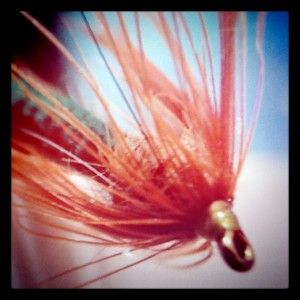
A recent comment on fishing wet flies on one of Kirk Deeter’s must-read ‘Fly Fishing Jazz’ columns (where he explores every ridiculous nuance of this chock-full-of-idiosyncrasies sport) mentions the practice of the Leisenring Lift.
The comment links to an old newsletter page from our pals at Front Range about the practice, from a wet fly fisherman named Jim Leisenring. It seems like a really good technique to try out when you’re swinging wets, so I’m going to mirror it whole here rather than just an excerpt. (The page on Front Range looks like it might fall off the Internet at any time.)
…
By using the Leisenring Lift, a neophyte fly fisher can be transformed into a fish-catching expert. It can be successfully used for everything from streamers to dry flies.
In the years prior to World War II, Jim Leisenring, an ardent wet fly fisherman, developed a technique that dead-drifted a fly into a prime lie, then just as the fly reached the likely holding position of the fish, it would suddenly rise away, inciting the fish to strike. The angler stands at the edge of a current tongue and casts up and slightly across stream with a short controlled line. After the fly settles to the water, the rod tip is raised to keep only enough line on the water to allow the fly to sink. As the fly moves toward the angler, the rod tip is raised higher in order to prevent excess slack from forming on the water. Once the fly passes the angler’s position and heads down current, the rod tip is lowered, keeping pace with current’s pull on the line. This raising and lowering motion will keep the fly right on the bottom and drag-free during the length of its drift.
Once the rod has been returned to the horizontal position, it is held still, allowing drag to set in and the currents to swing the line across stream. As a result, the fly will be swept (lifted) to the surface like an ascending natural. This upward sweeping action is the “lift” part of Leisenring’s technique. It is important that the fly get down on the bottom quickly, so the angler should either weight the fly internally or add shot or a similar weight to the leader.
To increase the chances of a fish taking the fly, the angler may try timing the swing so that it begins in areas where a fish would naturally be holding, looking for food (a prime lie or a feeding lie).
To further enhance the fish-attracting abilities of the Leisenring Lift, the angler can couple the swing with a jigging and/or stripping action. Such motion will often entice a reluctant fish to strike.
Another approach that is very effective with minnow imitations, diving caddis adults, and any emerging insect, involves multiple lifts during the drift and the swing. Rather than trying to keep the fly continuously bouncing the bottom, the angler intermittently raises the rod high, pulling the imitation up toward the surface. The rod is then lowered again, allowing the fly to sink.
Applying the lift technique to dry fly presentation can be deadly. It is especially useful for representing those caddis that run on the surface after emergence. The angler fishes the adult pattern right up on top, drifting it over likely fish-holding areas. When the swing is initiated, the fly skates across the water’s surface, leaving a “v”-shaped wake, just like a running caddis. If the swing is coordinated to begin where a fish has been rising, the results can be explosive.
…